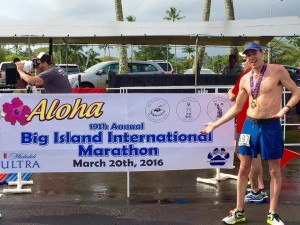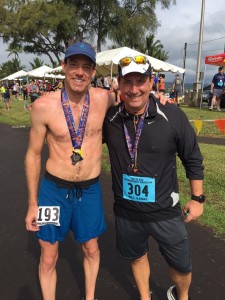Pacific Quest is supporting Mike Sullivan on his “2016 Road to Kona.” Yes, you heard correctly, Mike is taking another stab at the World Championship Ironman, assuming he is selected to participate through the Hawaii Resident Lottery on May 5, 2016. Mike will share insights and perspectives throughout his 2016 races and training, and drawing parallels between the mind-body connection and wellness – important themes at Pacific Quest.
In his first post, Mike shared his insights before the Hilo Marathon. With this second installment, Mike reflects on the marathon from this past Sunday:
By Mike Sullivan, MA, LMHC
Alumni and Family Services Director
A marathon is a point of convergence. It is the point where immense preparation meets performance. Every athlete strives to maximize performance on race day. In the Hilo International Marathon this past weekend, I drew upon planning, preparation, routines, strategy, a sense of belonging, and mental toughness. I have honed these skills both in my endurance athletics training and my work with youth at Pacific Quest, teaching youth the importance of self discipline, executive functioning, and resilience. The Hilo Marathon was a powerful convergence of many psychological factors, which I tactfully aligned, landing me in 5th place overall and qualifying me for the 2017 Boston Marathon!
in my endurance athletics training and my work with youth at Pacific Quest, teaching youth the importance of self discipline, executive functioning, and resilience. The Hilo Marathon was a powerful convergence of many psychological factors, which I tactfully aligned, landing me in 5th place overall and qualifying me for the 2017 Boston Marathon!
The Hilo Marathon was my first race of 2016. The race itself started long before race day. In order to arrive in a calm and balanced mental and physical state, developing routine was a critical tool. Since recovering from the 2015 Kona Ironman last fall, I have incorporated a morning routine that includes a variety of yoga asanas and foam roller techniques. The routine takes 45 minutes, and aims to minimize physical injury, and conjure a calm and present emotional state. It is a mindfulness practice that nurtures mental health and creates a solid foundation for the day ahead.
Mind-Body Training
When it came time to plan out the details for race day, I strove to maintain my routine. While the race itself is drastically different than training days, most coaches and athletes will advise, “Don’t do anything different on race day than you do in training days.” This advice is meant to calm anxiety within the athlete by de-emphasizing the significance of the feat ahead. Race events impose increased anxiety with the impending performance apex, applying more pressure on the athlete than a regular training day. Routines reinforce familiarity and ritual, a major combatant to anxiety. Thus for race day, I planned a 4:00 AM wake up followed by a mini version of my daily routine. This helped me to manage race anxiety, however, there is a fulcrum point with racing that thrives on a bit of anxiety. The neurotransmitters emitted from competition and increased pressure heightens focus, and athletes who are able to harness the balance, are able to achieve amazing feats. My routine kept the levels of anxiety in check, allowing me to calibrate my focus appropriately.
The day before the race I focused on mental and physical preparation. In order to continue to calibrate my anxiety level, decrease chaos, and minimize mental clutter, I prepared my belongings and mentally walked through my morning routine. I practiced the order of operations several times to ensure I was prepared and had everything accounted for. It started with setting my yoga mat and foam roller out in the living room, lining up all my breakfast items on the counter, and then arranging my running equipment by the door– shoes, shorts, nutrition, water, etc. I awoke before my alarm was set to sound and calmly cruised through my morning routine, arriving at the race 45 minutes prior to the start. Sports psychologists say it is equally important for athletes to be prepared for unknown obstacles to emerge, however, in this instance I didn’t have to navigate any. Whew!
 A sense of community and support flourished and created a positive vibe at the starting line. Surrounded by many friends and Pacific Quest coworkers, encouragement was abounding. Mark Agosto, my boss and mentor, brought great energy and enthusiasm to the starting line, giving me an extra pep talk and champion-like confidence. The gun sounded marking the start of the race and the 100+ racers jetted off the starting line. Spectators cheered and athletes hooted and hollered. A sense of belonging within a community is widely understood to be important for wellbeing and increased self-esteem. I am grateful for the Big Island community and all the wonderful connections I have developed through athletics. It certainly contributed to a successful race.
A sense of community and support flourished and created a positive vibe at the starting line. Surrounded by many friends and Pacific Quest coworkers, encouragement was abounding. Mark Agosto, my boss and mentor, brought great energy and enthusiasm to the starting line, giving me an extra pep talk and champion-like confidence. The gun sounded marking the start of the race and the 100+ racers jetted off the starting line. Spectators cheered and athletes hooted and hollered. A sense of belonging within a community is widely understood to be important for wellbeing and increased self-esteem. I am grateful for the Big Island community and all the wonderful connections I have developed through athletics. It certainly contributed to a successful race.
Mind-Body Training & Race Strategy
I ran the first half of the race at a moderate pace – roughly 6:50 min/mile. This was aligned with my race strategy, a plan I created from studying the course and planning for physical and mental challenges. The beginning of the course, where it gains more elevation than it loses, is where athletes can burn themselves out physically or mentally. I planned to start at a moderate pace and speed up in the second half. Indeed, my body was feeling strong toward the second half and I was able to increase my pace. I never hit a “wall” in this race, and was able to stay consistent through the final miles. I finished with a smile in 2:57:29.
Throughout the race I employed mental toughness I established during training. I completed 20-mile training runs every Sunday in the blistering Hilo heat leading up the race. This taught me persistence and proved to myself that I could keep going, despite the aches, pains, and self doubts that emerged. I used my personal mantra of “keep pushing,” and “you can do this all day,” to maintain a fast pace throughout the race. I also kept it light and positive, smiling and encouraging fellow athletes along the way.
I meditated on the phenomena of peak performance throughout training and the race. I thought about the parallels racing has with performance in various contexts. My mind returns to the organic gardens of Pacific Quest. What lessons from racing are similar to gardening, and can be applied to other spheres of performance? Whether in a race, an organic garden, or at school, youth must learn to manage responsibility in their daily lives- completing tasks, managing anxiety, overcoming self doubt. Utilizing the same tools I drew on in the race can absolutely be applied to a variety of contexts, whether it is school, job, or an array of emotional struggles. Check out my PEAK Self article on Seven Tools For Peak Performance for more information.
I want to thank Pacific Quest for the support throughout the race. I also want to thank the amazing Hilo community, Big Island Running Company, and my elaborate family/friend network throughout the world for encouraging my racing habit and interest in sports psychology. I will continue to utilize my own experience and research themes related to sports psychology as I hone my PEAK Self and help others to do the same. Bring on Boston 2017!
Congrats to Mike from your PQ ohana! We are so excited for you!